Magic Filter Review
Magic Filter
When Alex Mustard first announced the Magic Filter I was pretty excited as I was in the market for a red filter for my newly purchased 10.5mm wide angle lens. I was interested in a red filter because I wanted to experiment with the manual White Balance option that a digital SLR offers. As a full time underwater image maker, a lot of my work involves video and in the realm of underwater video, the red filter is king. When shooting video without lights and manually white balancing off a slightly off white slate, rich saturated colour can be captured from further away than what can be obtained using strobes on a still camera.
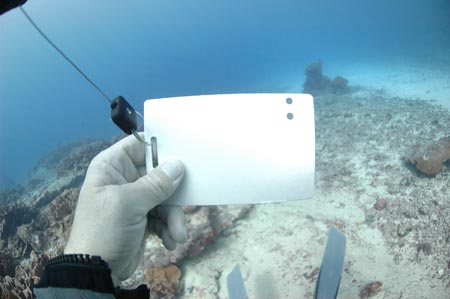
I was interested in putting the Magic to the test and seeing what it could do when used in situations that it wasn’t necessarily designed for. A few of the ideas I wanted to test were: shooting into the sun, shooting on the surface (split shots), and shooting with strobes. Strobes?!? I am sure this statement makes a few people cringe in disgust as who wants a red photo?! When shooting video, a very common practice is to leave the red filter on during night dives and WBing on a slate using the lights to illuminate it. This creates a very pleasing warming result and is my preferred method. My theory was the camera would work exactly like video and therefore strobes would work no problem…IF…the WB was done whilst setting off the strobes at the same time. My main inquiry into this was the fact the filter cannot be taken on and off during a dive and therefore I would imagine people will leave the strobes on the boat when using the filter. Of course, when this happens the clouds will roll in and rain will appear and create dark conditions not suitable for filter photos and leading many a photographer to lament the fact the strobes are not attached to the camera. Although I wasn’t planning on experimenting with this on the first day, I lost the plug for my synch connector and was forced to keep my strobes attached.
The first test was to attach the filter and try it on land. I used a white wall to calibrate and then took a photo of the same wall after. I discovered the WB on my camera was working properly as the wall came out white, just as it should. This should be everyone’s first test as it will alleviate anxiety about whether the WB of the camera is functioning properly.
The plan for my first dive was to jump into a clear, bright, incoming tide with the chance to shoot mantas feeding in shallow water. Alas, this turned out not to be the case as the tide was running out much earlier than scheduled, mother nature at her best! Instead, I stationed myself at around 50ft of depth and shoot up at the mantas on the cleaning station in relatively murky, green water. Although it was not what I envisioned for my first “Magic” experience, it was an ideal situation to test the abilities of manual WB with a digital SLR.
As stated in the “Magic” instructions, and also what holds true for video, the key to proper WB is to set the WB at the depth you will be shooting. What the instructions don’t mention is that the WB should also be set in the direction of shooting. In other words, best results will not be achieved if the camera is pointed down at the reef for WB and then turned up to shoot a photo. This is where my experience shooting video came in handy. Unfortunately, I did not bring my WB slate with me for this dive and I had nothing to WB on when shooting up at a manta, therefore I set the WB by pointing the camera directly at the sun, something I often do with video when I am having trouble setting the WB. I then concentrated on trying to capture a silhouette of a manta. Although this is certainly not what the Magic Filter was designed for, I wanted to know if I could still take that sort of shot without a red tinge as I had to deal with the cards I had been dealt. What resulted from this experiment was a clean image with no red streaks but of course some ugly green water.
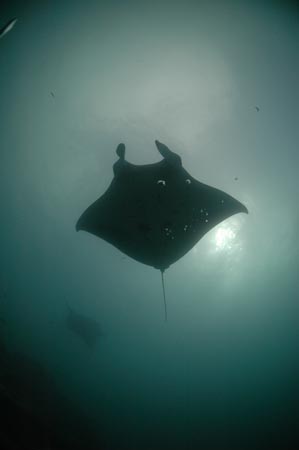
50 ft, f4, 1/400
Well, what if I tricked the WB into giving me a cooler colour cast instead? How? By turning on my strobes and WBing into a rock. I then turned the strobes off again and tried another shot, the result was a pretty decent blue that was in fact better than the conditions at hand.
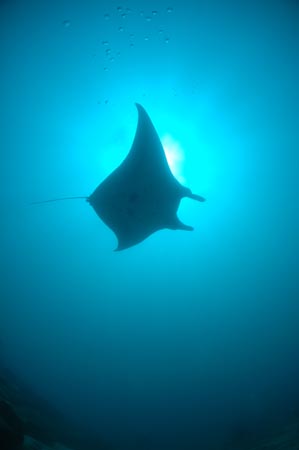
50 ft, f5, 1/250
For the second dive, I ventured out to clear water on a shallow reef to put the filter through the paces in a situation it was designed for. With clear water and bright sun, I was able to catch a few interesting images.
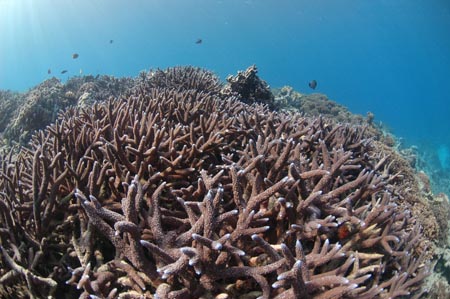
20ft, f4.5
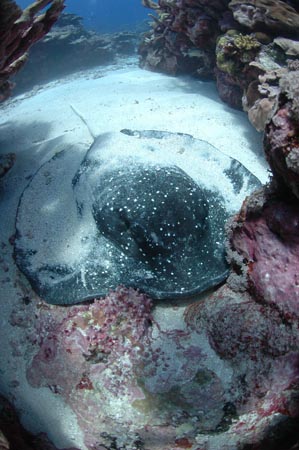
f5, 1/80
I thought this would be a perfect opportunity to try out another test. What happens when you come upon an interesting subject that is not in good light or when the rain comes tumbling down? Therefore, I decided to turn on my strobes and hit the WB. The camera gave me a reading of “good” and I decided to try my luck with close focus of an anemone. The results I must say were rather outstanding. I was afraid that perhaps the image would come out with a red cast but the camera’s WB feature was more than up to the task.
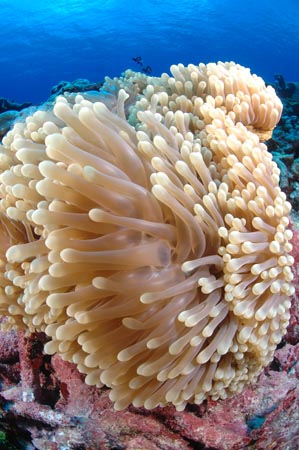
35 ft, f14, 1/40
Second Day
For the second day, I decided to bring my WB slate with me. The reason for that was I wanted to take photos aiming straight ahead and utilizing a model. In order to WB in the direction I wanted, I felt the WB slate would come in handy. The conditions were far superior the second day and my model/friend Melody joined me so I was able to experiment a bit more with distances. One of the problems with model photography is it is difficult to properly expose both the main subject and the model when using strobes. This is due to composition and strobe to subject distance when the two subjects are often at different distances from the camera. This is where I hoped the Magic Filter would really come in handy. And sure enough, it performed as advertised! I was able to capture even lighting and rich saturation of both my model and the coral without difficulty.
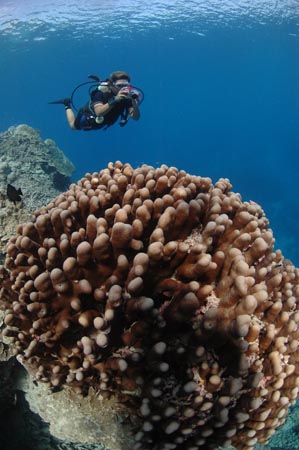
20 ft f5.6, 1/80
A pet peeve of mine has been trying to achieve even lighting on large objects such as Lettuce Coral. Strobes just don’t throw enough light to expose coral 15 feet away from the camera and photos of such subjects with strobe can only light up the first 6 or 7 feet creating a strange blue shadow across the far edges. I have tried this with ambient light, as well as manual WB without a filter, and have never been pleased with the results. Trying to capture a pleasing photo of this subject was one of the main reasons for purchasing the Magic Filter. Once again, the Magic Filter came through flawlessly and produced rich colour from front to back of this subject in 45 feet of water.
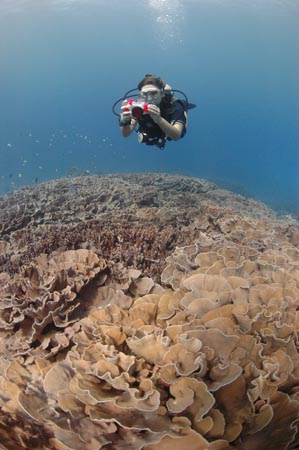
40 ft f4.5, 1/50
My last test consisted of more mixed lighting techniques. We dove a site called Yap Caverns which has beautiful swim throughs and fissures in very shallow water. Most previous photos from that dive were natural light and I have had mixed results. Again, photos come out pretty blue as that is what there is to work with. And when using strobes, the colour is fine in the foreground but fades off rather quickly creating strange shadows. The two photos below are without filter. Unfortunately, I don’t have a great second example as it was shot toward the sun but the strobe fall off is evident and the colours are still rather green.
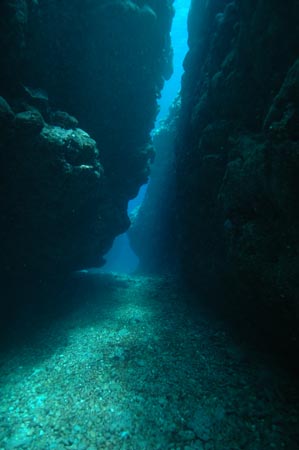
20ft f4, 1/125
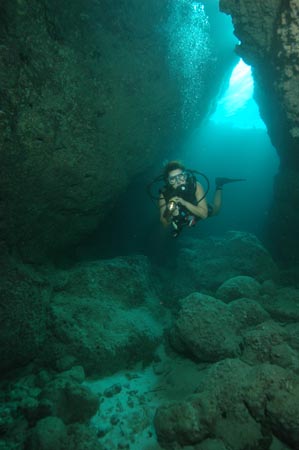
20ft, f4, 1/400
This was another area I felt the Magic Filter would earn its keep if it performed well. Sure enough, it did! The fact it could bring out a touch of red in the wall at least 20 feet away was a big surprise to me, as I thought there was no way it could push through that much water, I was wrong but happy.
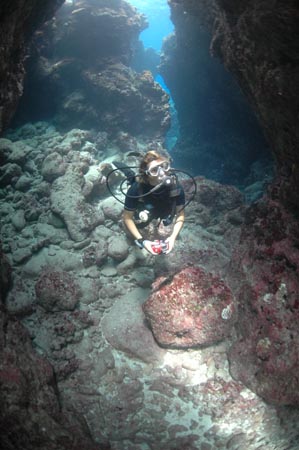
20 ft, f2.8, 1/25
The last photo was a difficult one to balance light, I was inside a cave and shooting toward the light. I used an extremely open setting ISO 400, f 2.8, and 1/15 to get the exposure correct in the foreground. I expected a fairly green/blue image but the filter again introduced some nice colours on the rocks, a bit of a surprise there. However, introducing a modeling light did create what I thought would happen. I WB’d in the direction I was going to shoot and then had my model swim into the photo pointing a light toward me, as I thought, it came out red. Introducing lights after WBing will always create this effect, fortunately we only had a small light so it doesn’t distract too much from the photo.
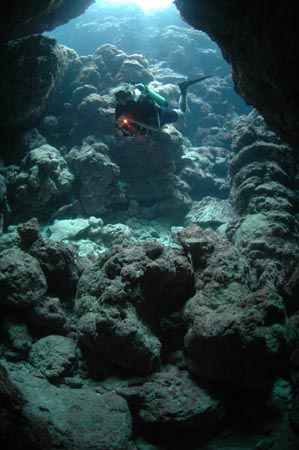
30ft, f2.8, 1/15 ISO 400
Conclusion
All of the photos used in this article are straight jpegs from the camera using the jpeg/raw function and 200 ISO except where noted. No enhancements, colour correction, or exposure compensation has been introduced. I felt this would be the fairest way of showing how the Magic Filter performs. Obviously, a few tweaks here and there can be made to the photos to bring out the best but I thought that would be misleading information to those who are interested in what benefits the Magic Filter can do for natural light photography.
I am extremely pleased with the performance and versatility of this new tool and quite pleased with the performance of my cameras manual WB ability. My main worry of using the Magic Filter was that I would put it in my camera and then be stuck using it on dives where the conditions weren’t ideal. Well, I don’t have that worry anymore as I was able to overcome that through WB with the strobes and getting great results. I am now confident enough with the system to take it on any dive along with my strobes and not worry about missing any photo opportunities. Although I did have a few problems getting the WB to take on several occasions, this was due to lack of light at depth of 70 feet when the sun went behind the clouds. This can be overcome by WBing with the strobes and then concentrating on taking close focus type photos with the strobes turned on. As long as the exposure is correct and the WB is performed in the proper direction, I believe most photographers will be very happy with the results of the Magic Filter. I know I will not hesitate to attach it to my camera but am a little disappointed for not giving myself the opportunity to dive sans strobes….
One more pic straight Magic Filter, although not the best example, it gives me reason to believe that splits in shallow water will be fantastic.
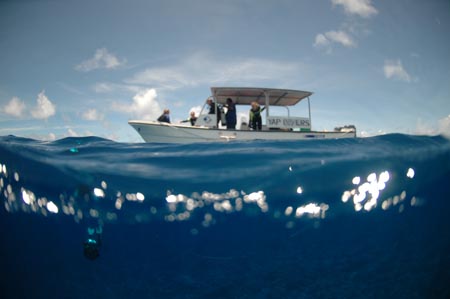
f2.8 1/1000